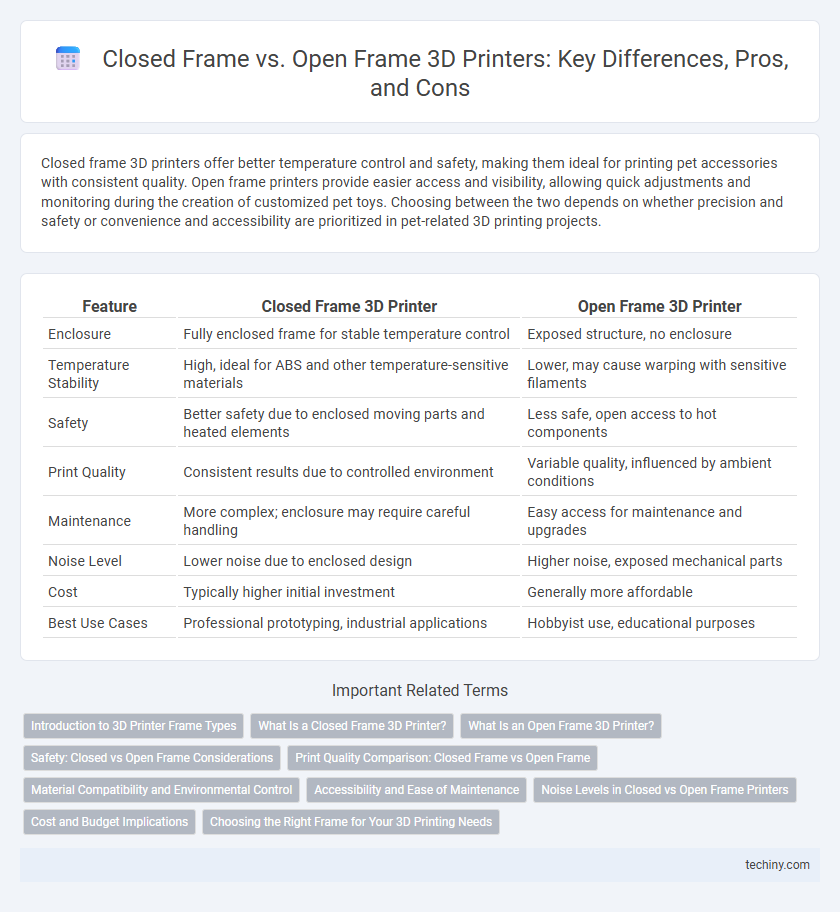Closed frame 3D printers offer better temperature control and safety, making them ideal for printing pet accessories with consistent quality. Open frame printers provide easier access and visibility, allowing quick adjustments and monitoring during the creation of customized pet toys. Choosing between the two depends on whether precision and safety or convenience and accessibility are prioritized in pet-related 3D printing projects.
Table of Comparison
| Feature | Closed Frame 3D Printer | Open Frame 3D Printer |
|---|---|---|
| Enclosure | Fully enclosed frame for stable temperature control | Exposed structure, no enclosure |
| Temperature Stability | High, ideal for ABS and other temperature-sensitive materials | Lower, may cause warping with sensitive filaments |
| Safety | Better safety due to enclosed moving parts and heated elements | Less safe, open access to hot components |
| Print Quality | Consistent results due to controlled environment | Variable quality, influenced by ambient conditions |
| Maintenance | More complex; enclosure may require careful handling | Easy access for maintenance and upgrades |
| Noise Level | Lower noise due to enclosed design | Higher noise, exposed mechanical parts |
| Cost | Typically higher initial investment | Generally more affordable |
| Best Use Cases | Professional prototyping, industrial applications | Hobbyist use, educational purposes |
Introduction to 3D Printer Frame Types
Closed frame 3D printers feature an enclosed design that enhances temperature stability and reduces exposure to dust and debris, improving print quality and safety. Open frame 3D printers offer greater accessibility and visibility, making them ideal for rapid prototyping and educational purposes. Selecting between closed and open frame designs depends on the specific printing needs, such as precision, material compatibility, and workspace environment.
What Is a Closed Frame 3D Printer?
A closed frame 3D printer features an enclosed build chamber that maintains a controlled environment, improving print quality and temperature stability, especially with materials like ABS and nylon. This design reduces warping by minimizing exposure to drafts and fluctuating temperatures while enhancing safety by containing fumes and hot components. Closed frame printers are ideal for precise, high-quality prints and use in settings where environmental control is critical.
What Is an Open Frame 3D Printer?
An open frame 3D printer features an exposed design where the print area is not enclosed by walls or a cover, allowing easy access to the print bed and extruder during operation. This type of printer is typically more affordable, lightweight, and offers enhanced visibility of the printing process. However, open frame 3D printers may be more susceptible to temperature fluctuations and dust, which can affect print quality and material consistency.
Safety: Closed vs Open Frame Considerations
Closed frame 3D printers provide enhanced safety by enclosing moving parts and hot components, reducing the risk of burns and accidents, especially in environments with children or inexperienced users. Open frame printers expose the build area, increasing the chance of contact with heated nozzles or mechanical parts, which may lead to safety hazards. For industrial or educational settings prioritizing user protection, closed frame models offer superior containment of fumes and debris, improving overall operational safety.
Print Quality Comparison: Closed Frame vs Open Frame
Closed frame 3D printers provide enhanced print quality by maintaining a stable temperature and reducing environmental influences such as dust and drafts, resulting in consistent layer adhesion and minimized warping. Open frame printers offer greater accessibility and visibility but are more susceptible to temperature fluctuations and external particles, which can compromise print precision and surface finish. The choice between closed and open frame designs significantly impacts dimensional accuracy and the overall reliability of printed parts.
Material Compatibility and Environmental Control
Closed frame 3D printers provide superior environmental control, maintaining consistent temperature and humidity levels that enhance print quality and reduce warping, especially when using ABS, nylon, and other temperature-sensitive materials. Open frame printers offer greater accessibility and visibility, but their exposure to ambient conditions can lead to inconsistent results with hygroscopic filaments like TPU and PETG. For applications requiring precise material compatibility and controlled environments, closed frame models are generally more reliable for producing high-quality, durable prints.
Accessibility and Ease of Maintenance
Closed frame 3D printers offer enhanced safety and reduced exposure to fumes, but their enclosed design can limit easy access to internal components, making maintenance tasks more challenging. Open frame models provide straightforward accessibility to the print area and mechanical parts, facilitating quicker troubleshooting and routine upkeep. Choosing between closed and open frame depends on the balance between maintaining operator safety and ensuring ease of printer maintenance.
Noise Levels in Closed vs Open Frame Printers
Closed frame 3D printers typically produce lower noise levels compared to open frame models due to their enclosed design that dampens operational sounds from motors, fans, and moving parts. This noise reduction enhances the printing experience, making closed frame printers more suitable for office or home use where quieter environments are preferred. Open frame printers, lacking enclosure, often generate higher decibel levels, which can be disruptive in noise-sensitive settings.
Cost and Budget Implications
Closed frame 3D printers typically have a higher upfront cost due to their robust enclosed design, which enhances print quality and safety but adds to manufacturing expenses. Open frame models generally offer a more budget-friendly option, ideal for hobbyists or low-risk environments, but may result in lower print consistency and increased maintenance needs. Budget-conscious buyers should weigh the initial investment against long-term benefits like durability, print precision, and workplace safety when selecting between closed and open frame printers.
Choosing the Right Frame for Your 3D Printing Needs
Closed frame 3D printers offer enhanced temperature control and dust protection, making them ideal for printing high-precision parts with materials like ABS and nylon. Open frame printers provide easier access for modifications and maintenance, suitable for beginners and rapid prototyping with PLA. Evaluating the print environment, material requirements, and user experience guides the optimal choice between closed and open frame 3D printers.
Closed Frame vs Open Frame Infographic

 techiny.com
techiny.com